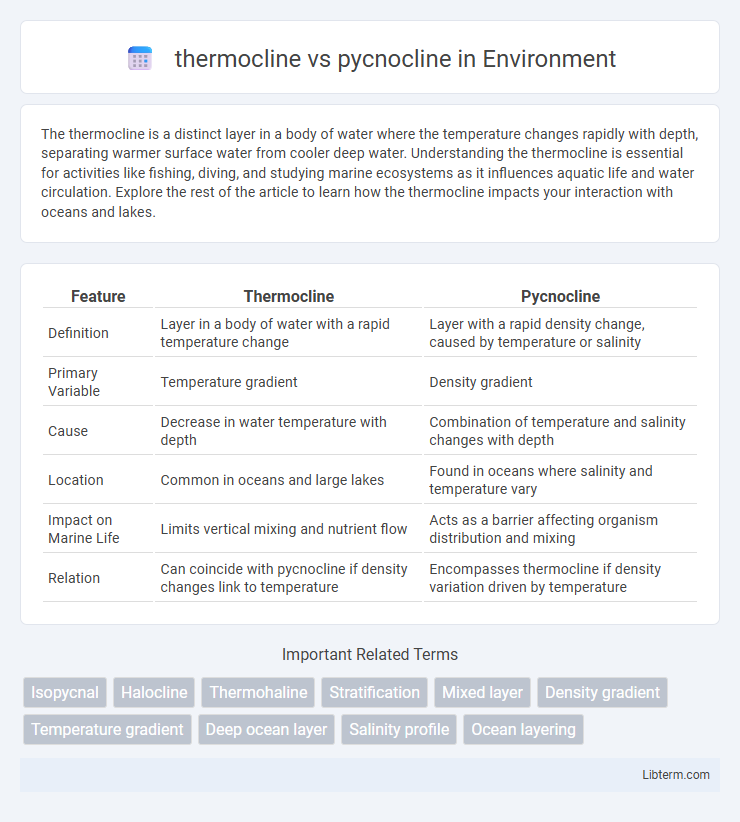The thermocline is a distinct layer in a body of water where the temperature changes rapidly with depth, separating warmer surface water from cooler deep water. Understanding the thermocline is essential for activities like fishing, diving, and studying marine ecosystems as it influences aquatic life and water circulation. Explore the rest of the article to learn how the thermocline impacts your interaction with oceans and lakes.
Table of Comparison
| Feature | Thermocline | Pycnocline |
|---|---|---|
| Definition | Layer in a body of water with a rapid temperature change | Layer with a rapid density change, caused by temperature or salinity |
| Primary Variable | Temperature gradient | Density gradient |
| Cause | Decrease in water temperature with depth | Combination of temperature and salinity changes with depth |
| Location | Common in oceans and large lakes | Found in oceans where salinity and temperature vary |
| Impact on Marine Life | Limits vertical mixing and nutrient flow | Acts as a barrier affecting organism distribution and mixing |
| Relation | Can coincide with pycnocline if density changes link to temperature | Encompasses thermocline if density variation driven by temperature |
Introduction to Thermocline and Pycnocline
Thermocline refers to a distinct layer in a body of water where the temperature changes rapidly with depth, typically found between the warmer upper mixed layer and the colder deep water. Pycnocline is the oceanic layer characterized by a sharp density gradient caused by variations in temperature and salinity, affecting water column stability and stratification. Both thermocline and pycnocline play crucial roles in ocean circulation, marine ecosystems, and nutrient distribution by influencing vertical mixing processes.
Defining Thermocline: Temperature Gradients in Water
The thermocline is a distinct layer in a body of water where temperature rapidly decreases with depth, creating a steep temperature gradient that separates the warmer surface water from the colder deep water. It plays a critical role in aquatic ecosystems by influencing water density, nutrient mixing, and marine life distribution. Unlike the pycnocline, which is defined by changes in water density due to variations in both temperature and salinity, the thermocline specifically refers to temperature-driven stratification.
Understanding Pycnocline: Density Variations Explained
The pycnocline is a distinct oceanographic layer characterized by a rapid change in water density, primarily driven by variations in temperature and salinity. Unlike the thermocline, which specifically marks sharp temperature gradients, the pycnocline integrates both temperature and salinity factors, making density the key parameter. Understanding pycnocline dynamics is essential for studying ocean stratification, nutrient mixing, and marine ecosystem distribution.
Causes of Thermocline Formation
Thermocline formation results primarily from solar radiation heating the ocean surface, creating a temperature gradient that separates warmer surface water from colder deep water. This stratification inhibits vertical mixing, driven by reduced heat transfer and differential water density. Variations in solar intensity, seasonal changes, and ocean currents further influence the strength and depth of the thermocline layer.
Factors Influencing Pycnocline Development
The pycnocline development primarily depends on the density gradient caused by variations in temperature and salinity, with salinity often playing a more critical role in marine environments. Thermoclines, characterized by temperature gradients, influence the upper layer's stability but interact with salinity changes to strengthen or weaken the pycnocline. Ocean circulation, freshwater input, and seasonal heating significantly affect pycnocline intensity by altering temperature and salinity distributions in the water column.
Key Differences: Thermocline vs Pycnocline
The thermocline is a distinct layer in a body of water where temperature changes rapidly with depth, whereas the pycnocline is defined by a rapid change in water density, primarily influenced by variations in temperature and salinity. While the thermocline mainly reflects thermal stratification, the pycnocline integrates both thermal and haline factors, making it a more comprehensive indicator of density gradients. These differences impact ocean circulation, nutrient mixing, and marine life distribution in aquatic ecosystems.
Oceanographic Significance of Thermoclines
Thermoclines represent a distinct temperature gradient in ocean waters, playing a crucial role in regulating heat distribution and influencing marine life habitats by creating layers with varying temperatures. This thermal stratification affects nutrient cycling and ocean circulation patterns, impacting biological productivity and climate regulation. Understanding thermoclines enhances predictions of ocean behavior, fishery dynamics, and climate change responses.
Ecological Importance of Pycnoclines
Pycnoclines play a critical ecological role by creating strong density gradients in aquatic environments that limit vertical mixing of nutrients and oxygen, thus shaping habitat stratification for marine and freshwater organisms. These density barriers influence species distribution by controlling the movement of plankton and larvae, promoting biodiversity and supporting complex food webs. Compared to thermoclines, pycnoclines integrate both temperature and salinity effects, making them fundamental in regulating biogeochemical cycles and maintaining ecosystem stability in oceans and lakes.
Thermocline and Pycnocline in Climate Studies
The thermocline, a layer in ocean water where temperature rapidly decreases with depth, plays a crucial role in regulating heat distribution and influencing ocean circulation patterns critical to climate models. The pycnocline, defined by a sharp density gradient primarily caused by variations in temperature and salinity, significantly affects stratification and nutrient cycling in marine ecosystems. Understanding interactions between the thermocline and pycnocline enhances predictions about ocean-atmosphere exchanges and their impact on climate variability and long-term climate change.
Impacts on Marine Life and Human Activities
The thermocline affects marine life by creating temperature gradients that influence species distribution, breeding patterns, and nutrient availability, often limiting vertical movement of organisms due to thermal barriers. The pycnocline, characterized by rapid changes in water density, impacts nutrient cycling and oxygen levels, which directly affect fish habitats and productivity in fisheries. Human activities such as fishing, submarine navigation, and climate monitoring are influenced by these layers, as they alter sonar performance, nutrient upwelling, and ecosystem dynamics critical for sustainable resource management.
thermocline Infographic

 libterm.com
libterm.com